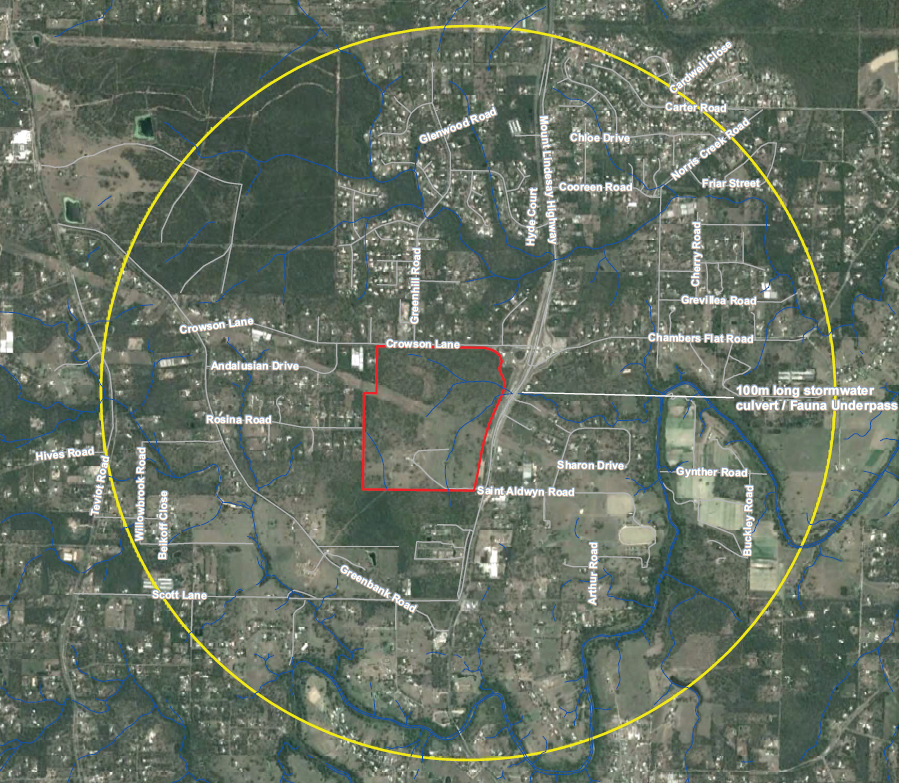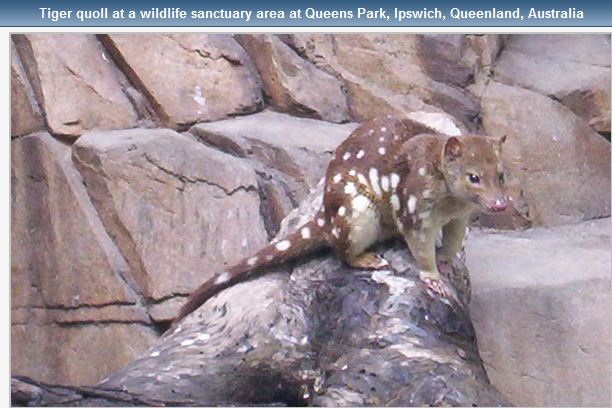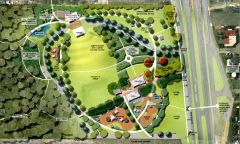
Logan and Albert Conservation Association

Reasons for objecting to concept plan as presented are summarised below. They are extracted from the whole document file you can download
![]() Community-MIRVAC-SubmissionLetter_Dec16.2016-rev.pdf
Community-MIRVAC-SubmissionLetter_Dec16.2016-rev.pdf
![]() Community-MIRVAC-SubmissionLetter_Dec16.2016-rev.docx
Community-MIRVAC-SubmissionLetter_Dec16.2016-rev.docx
The environmental values of this 482 hectare property (the largest land holding in the area and local landscape) provides a critical stepping stone in the landscape, fauna movement corridors that cannot be replaced in this location – offsets will never compensate for the loss of this environmental asset.
“ the subject site remains one of the last large rural properties in the immediate landscape predominantly comprised of rural residential development” (Saunders Havill Group MIRVAC TECHNICAL ECOLOGICAL ASSESSMENT REPORT p 3)
Endangered species future in doubt at North Maclean?
Have YOU been consulted? Comments close 9 March 2015

Koalas, spotted tailed quolls, grey headed flying foxes, glossy black cockatoos, wallum froglet are known to be using / living in the extant habitat within the former dairy farm having road frontage along Mt Lindesay and Crowson Lane.
Wetland and waterways occur on the property as does the federally endangered ecological community known as Swamp Tea-tree forest with signature Melaleuca Irbyana species. Regional ecosystem descriptions 12.3.11 of concern and 12.9-10.12 endangered are present. Glossy black cockatoos or Glossies in QLD eat the seeds of only two allocasuarina trees:Allocasuarina littoralis andA. torulosa. Having a very restricted diet the Glossy Black Cockatoo is susceptible to habitat loss through land clearing,logging, agriculture and urban development. A. littoralis is present and clearing is proposed – without mitigation.
Environmental Submission writing kit for the Draft Logan Planning Scheme
due: deadline 5 pm Wednesday 30 April
Logan and Albert Conservation Association have 5 key concerns relating to the strategic planning that underlies the planning documents. We have explained the background behind each concern and make a recommendation for how those values - which are core values for our organisation - could be improved. Please read the following document to read all 5 points. The first 3 points are covered in the pdf document lower down the page. Regional biodiversity corridors and Priority Development Areas (PDAs) are the last 2 points added.
Planning_Scheme_Environmental_Submission_writing_kit.5points_docx.pdf
Do not include attachments (which would have to be digitally signed) unless you need to
Submissions must be properly-made for Council to consider your feedback. A properly made submission means:
• You must include the full name and address of each person making the submission
• Submissions must state the grounds for the submission and the facts or circumstances to support the grounds. See text in red below
Apart from email submissions (preferred) written submissions - posted letters or email attachments, but NOT emails, must be signed by each person making the submission
So the simplest and best option for submissions is to direct email This email address is being protected from spambots. You need JavaScript enabled to view it.
Submissions can also be made Via post to Logan City Council, PO Box 3226, Logan City DC, Qld 4114, but have to arrive by 5 pm Wednesday 30 April
Significant environmental concerns to comment on include
Koala mapping not included as statutory overlay in Draft Planning Scheme
Offsetting and the Council’s flawed Ecological Significance scoring
Limited locally significant flora and fauna mapping
Background information for each is provided to explain why Logan and Albert Conservation LACA and others are concerned.
1. Koala mapping not included as statutory overlay in Draft Planning Scheme
Background: While out of date mapping of Koala habitat does appear in the Draft Planning Scheme, this is not legally supported mapping (ie not statutory) and therefore has little chance of being defended in a court challenge.
Here you find an example of what you can write:
In your email submission, you could copy and paste the text in red below the background, or say the same things in your own words.
Make sure you include the second part - ‘My proposed change to the Draft Logan Planning Scheme’
It is important that you make a submission to protect the biodiversity of our region - the flora and fauna - endangered threatened rare and common that together with our waterways make SOUTH EAST QUEENSLAND the special ecological region that it is.

Our organization is regarded by some as extreme and anti-development, however we do support ecological sustainable development, and accounting for the value of natural capital. Many scientific studies and reports - peer reviewed and published - support our concerns. It is extraordinary that scientists with expertise in biodiversity conservation and sustainable development have publicly expressed grave concerns about the future impacts of proposed changes to Queensland's Vegetation Management Act and the Water Act. See their website http://concernedqldscientists.wordpress.com/.
Be informed and read government documents
Vegetation Mananagement Framework Bill - passed State Parliament Tuesday 21 May 2013. Natural Resources Minister Andrew Cripps said in a statement issued to Queensland Country Life that the passing of the Vegetation Management Framework Amendment Bill 2013 marked the beginning of a new era of sustainable agricultural production in Queensland
In addition World Wildlife Fund have produced WWF Report – Bushland at risk of renewed clearing in Queensland. Read it here.
Prominent among threatened species are the koala, Glossy black-cockatoo, Spotted-tailed and northern quolls. Many of us "do the right thing" but equally we are not necessarily well informed. What do farmers understand by sustainable agriculture?
The traditional big agribusiness is not sustainable when all costs are accounted. Dollars certainly count but who will pay long term when land becomes desert - as has happened.
 LACA - Logan and Albert Conservation Association - will present a Glossy Black Cockatoo Workshop, presenting a comprehensive overview of this magnificient bird which is
LACA - Logan and Albert Conservation Association - will present a Glossy Black Cockatoo Workshop, presenting a comprehensive overview of this magnificient bird which is
sliding towards a "threatened" existence.
This is followed by a tour of the Glossy Conservation project at Mt Barney Lodge.
This workshop is sponsored through Scenic Rim Council environment grant to LACA and is hosted free of charge by Mt Barney Lodge.
Dr Guy Castley from Griffith University and lead research member will be guest presenter.
Well known SEQ bird person Rod Bloss from Brisbocca will also present on the day.
LACA, Mt Barney Lodge, Scenic Rim Council, Dr Guy Castley and Rod Bloss are all connected with the GLOSSY BLACK CONSERVANCY
 A draft master plan has been prepared to guide the future development of Logan West Parklands, which will be located minutes from the Park Ridge town centre on the Mt Lindesay Highway Service Road, next to Park Ridge High School.
A draft master plan has been prepared to guide the future development of Logan West Parklands, which will be located minutes from the Park Ridge town centre on the Mt Lindesay Highway Service Road, next to Park Ridge High School.
Council officers will be available at the following locations to discuss the master plan.
Council officers will be available to discuss the master plan. Last opportunity to comment on the Draft Landscape Master Plan with planners is at Park Ridge Village Mt Lindesay Hwy Service Rd Thursday 22 July 2 pm to 4 pm.
Documents council have currentl made available can be viewed or downloaded from this page.
What is not included for our background studies is the Flora and Fauna Management Plan. This is a contentious issue as such documents are essential components to all development plans - but are most often not readily accessible.
This is being envisioned as a tourist mecca. As such the online feedback at http://haveyoursaylogancity.com.au/loganwestparklands ask the following - most of which focus on the built environment and not the natural environment. Management of each and scenic amenity of each is vastly different.
What activities or facilities would make you and your family spend the day at Logan West Parklands?
What would be in your dream playground that we can include here?
What outdoor events would you like to see at Logan West Parklands?
Do you have any other comments, ideas or suggestions?
How could the environment centre become a valued asset for the Logan community?
The FAQs offer some suggestions you might like to comment on.
Glossy Black-Cockatoos are labelled as Vulnerable in Queensland and Threatened on a National Level. Presently, little is known about the current movements of the Glossy's populations and their specific habitat selection.
The Glossy Black-Cockatoo is located in the South-Eastern corner of Queensland, Eastern New South Wales, extending slightly into Victoria with populations known in South Australia and Kangaroo Island.
Glossy Black-Cockatoos are specialized feeders of Allocasuarina seeds (Allocasuarina torulosa, Allocasuarina littoralis) and some Casuarina species (Casuarina equisetifolia). They feed from the seeds located within the barky cone. Allocasuarina species are frequent in the Gold Coast and South-east Queensland region. These trees grow throughout Logan and Scenic Rim Region. Allocasuarina littoralis grows extensively in south west Logan - an area targeted by state government and Logan council as identified future growth areas. Allocasuarina torulosa grows extensively in the ranges and higher ridges of Scenic Rim.
Population
Total population estimates as of 2006 were less then 18 000. As of 2005, there was a declining population of Glossy Black-Cockatoos in Queensland, with estimates of population numbers being between 1000 and 2500. On the Gold Coast population numbers are unknown.
Conservation status and threats
All states in which Glossy Black-Cockatoos are located have been labeled Vulnerable or Endangered. The Australian Government has declared the status of the Glossy Black-Cockatoo, on a national level, as Threatened.
Roosting/breeding trees are being cleared throughout the South-Eastern Queensland region. Suitable trees for breeding are usually large with the presence of hollows in which the cockatoos can adequately roost and breed. Native Australian trees, like Eucalyptus Species, take a considerable amount of time to form large hollows.
Identification
Females can be told apart from males via blotches of yellow located on the head and neck. The head may also be darker then the male. Juveniles will also have a darker head with small spots on the shoulder or breast.
Feeding
Glossy Black-Cockatoos feed on the seeds of Allocasuarina species with the Black She-Oak (Allocasuarina littoralis) being the favored Allocasuarina species. They have been recorded spending approximately 88% of the day foraging for Allocasuarina seeds.
Breeding
Breeding occurs every two years with a single egg being laid in late January to early June with a longer nestling period then any other cockatoos (up to 90 days). Large hollow trees are needed for a breeding site and they are known to have a breeding life span that can exceed 30 years.
Dr Guy Castley from Griffith University is leading The Glossy Black-Cockatoo project which aims to assess the current distribution and habitat use of Glossy Black-Cockatoos in the Gold Coast area in order to ensure that habitat preservation for the Glossy Black-Cockatoo can be made with greater accuracy and ensure their survival in the future.